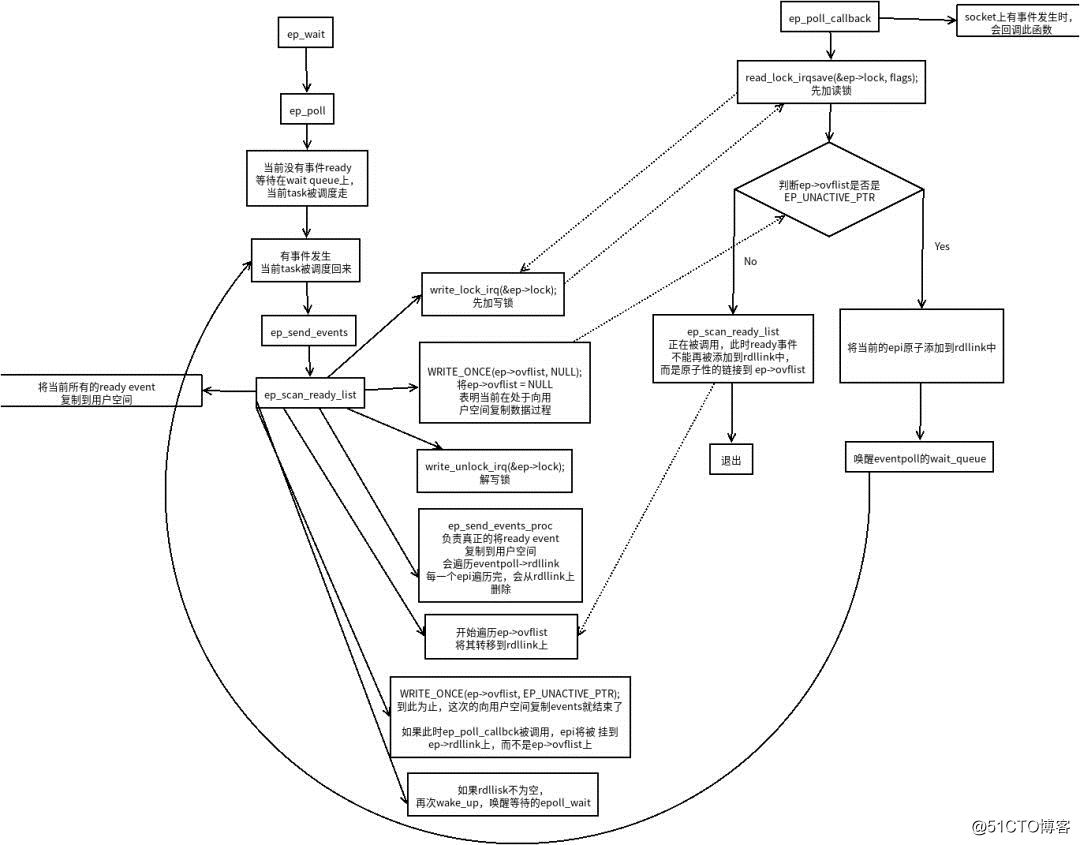刘伟 360云计算
女主宣言
epoll是linux上的IO多路复用的一种实现,内核在实现时使用的数据结构相比select要复杂,但原理上并不复杂,我们力求在本文的描述里抽出主干,理清思路。
PS:丰富的一线技术、多元化的表现形式,尽在“360云计算”,点关注哦!
1
前言
epoll利用了Linux中的重要数据结构 wait queue, 有了select的基础,其实epoll就没那么复杂了。
通过阅读本文 ,你除了可以了解到epoll的原理外,还可以搞清epoll存不存在惊群问题,LT和 ET模式在实现上有什么 区别,epoll和select相比有什么不同, epoll是如何处理多核并发的等等问题 。当然内容难免有疏漏之处,请大家多多指证。
2
主要数据结构
eventpoll

epoll操作最重要的数据结构,封装了所有epoll操作涉及到的数据结构:
struct eventpoll {// 用于锁定这个eventpoll数据结构,// 在用户空间多线程操作这个epoll结构,比如调用epoll_ctl作add, mod, del时,用户空间不需要加锁保护// 内核用这个mutex帮你搞定struct mutex mtx;// 等待队列,epoll_wait时如果当前没有拿到有效的事件,将当前task加入这个等待队列后作进程切换,等待被唤醒wait_queue_head_t wq;/* Wait queue used by file->poll() */// eventpoll对象在使用时都会对应一个struct file对象,赋值到其private_data,// 其本身也可以被 poll, 那也就需要一个wait queuewait_queue_head_t poll_wait;// 所有有事件触发的被监控的fd都会加入到这个列表struct list_head rdllist;/* Lock which protects rdllist and ovflist */rwlock_t lock;// 所有被监控的fd使用红黑树来存储struct rb_root_cached rbr;// 当将ready的fd复制到用户进程中,会使用上面的 lock锁锁定rdllist,// 此时如果有新的ready状态fd, 则临时加入到 ovflist表示的单链表中struct epitem *ovflist;// 会autosleep准备的唤醒源struct wakeup_source *ws;/* The user that created the eventpoll descriptor */struct user_struct *user;// linux下一切皆文件,epoll实例被创建时,同时会创建一个file, file的private_data// 指向当前这个eventpoll结构struct file *file;/* used to optimize loop detection check */int visited;struct list_head visited_list_link;#ifdef CONFIG_NET_RX_BUSY_POLL/* used to track busy poll napi_id */unsigned int napi_id;#endif};
我们将 上面结构体中的 poll_wait单提出来说一下,正如注释中所说的,有了这个成员变量,那这个eventpoll对应的struct file也可以被poll,那我们也就可以将这个 epoll fd 加入到另一个epoll fd中,也就是实现了epoll的嵌套。
另外,在下面的讲解中我们暂时不涉及epoll嵌套的问题。
epitem
由上面的介绍我们知道每一个被 epoll监控的句柄都会保存在eventpoll内部的红黑树上(eventpoll->rbr),ready状态的句柄也会保存在eventpoll内部的一个链表上(eventpoll->rdllist), 实现时会将每个句柄封装在一个结构中,即epitem:
struct epitem {// 用于构建红黑树union {/* RB tree node links this structure to the eventpoll RB tree */struct rb_node rbn;/* Used to free the struct epitem */struct rcu_head rcu;};// 用于将当前epitem链接到eventpoll->rdllist中struct list_head rdllink;//用于将当前epitem链接到"struct eventpoll"->ovflist这个单链表中struct epitem *next;/* The file descriptor information this item refers to */struct epoll_filefd ffd;/* Number of active wait queue attached to poll operations */int nwait;/* List containing poll wait queues */struct list_head pwqlist;// 对应的eventpoll对象struct eventpoll *ep;/* List header used to link this item to the "struct file" items list */struct list_head fllink;/* wakeup_source used when EPOLLWAKEUP is set */struct wakeup_source __rcu *ws;// 需要关注的读,写事件等struct epoll_event event;};
epoll_event
调用epoll_ctl时传入的最后一个参数,主要是用来告诉内核需要其监控哪些事件,我们先来看其定义。
在kernel源码中的定义
struct epoll_event { __poll_t events; __u64 data;} EPOLL_PACKED;
在glic中的定义
typedef union epoll_data{void *ptr;int fd;uint32_t u32;uint64_t u64;} epoll_data_t;struct epoll_event{uint32_t events; /* Epoll events */epoll_data_t data; /* User data variable */} __EPOLL_PACKED;
乍一看,为什么这两种定义不一样,这怎么调用啊?
我们先来看下glic中的定义,它将epoll_event.data定义为epoll_data_t类型,而epoll_data_t被定义为union类型,其能表示的最大值类型为uinit64_t,这与kernel源码中的定义__u64 data是一致的,其实这个data成员变量部分kernel在实现时根本不会用到,它作为user data在epoll_wait返回时通过epoll_event原样返回到用户空间,声明成 union对使用者来说自由发挥的空间就大多了,如果使用fd,你可以把当前要监控的socket fd赋值给它,如果使用void* ptr,那你可以将任意类型指针给它......
3
主要函数
epoll_create
创建一个epoll的实例,Linux里一切皆文件,这里也不例外,返回一个表示当前epoll实例的文件描述符,后续的epoll相关操作,都需要传入这个文件描述符。
其实现位于 fs/eventpoll.c里 SYSCALL_DEFINE1(epoll_create, int, size), 具体实现 static int do_epoll_create(int flags):
static int do_epoll_create(int flags){int error, fd;struct eventpoll *ep = NULL;struct file *file;/* Check the EPOLL_* constant for consistency. */BUILD_BUG_ON(EPOLL_CLOEXEC != O_CLOEXEC);// 目前flags只支持 EPOLL_CLOEXEC 这一种,如果传入了其他的,返回错误if (flags & ~EPOLL_CLOEXEC)return -EINVAL;/** Create the internal data structure ("struct eventpoll").*/error = ep_alloc(&ep);if (error < 0)return error;/** Creates all the items needed to setup an eventpoll file. That is,* a file structure and a free file descriptor.*/fd = get_unused_fd_flags(O_RDWR | (flags & O_CLOEXEC));if (fd < 0) {error = fd;goto out_free_ep;}file = anon_inode_getfile("[eventpoll]", &eventpoll_fops, ep,O_RDWR | (flags & O_CLOEXEC));if (IS_ERR(file)) {error = PTR_ERR(file);goto out_free_fd;}ep->file = file;fd_install(fd, file);return fd;out_free_fd:put_unused_fd(fd);out_free_ep:ep_free(ep);return error;}
主要分以下几步:
校验传入参数flags, 目前仅支持 EPOLL_CLOEXEC 一种,如果是其他的,立即返回失败;
调用ep_alloc, 创建 eventpoll结构体;
在当前task的打开文件的描述符表中获取一个fd;
使用 anon_inode_getfile创建一个 匿名inode的struct file, 其中会使用 file->private_data = priv将第二步创建的eventpoll对象赋值给struct file的private_data 成员变量。
关于匿名inode作者也没有找到太多的资料,可以简单理解为其没有对应的dentry, 在目录下ls看不到这类文件 ,其被close后会自动删除,比如 使用O_TMPFILE选项来打开的就是这类文件;将第三步中的fd和第四步中的struct file结合起来,放入当前task的打开文件描述符表中;
epoll_ctl
从一个fd添加到一个eventpoll中,或从中删除,或如果此fd已经在eventpoll中,可以更改其监控事件。
我们在下面的源码中添加了必要的注释:
SYSCALL_DEFINE4(epoll_ctl, int, epfd, int, op, int, fd,struct epoll_event __user *, event){int error;int full_check = 0;struct fd f, tf;struct eventpoll *ep;struct epitem *epi;struct epoll_event epds;struct eventpoll *tep = NULL;error = -EFAULT;// ep_op_has_event() 其实就是判断当前的op不是 EPOLL_CTL_DEL操作,// 如果 是EPOLL_CTL_ADD 或 EPOLL_CTL_MOD,// 将event由用户态复制到内核态//if (ep_op_has_event(op) &©_from_user(&epds, event, sizeof(struct epoll_event)))goto error_return;error = -EBADF;f = fdget(epfd);if (!f.file)goto error_return;/* Get the "struct file *" for the target file */tf = fdget(fd);if (!tf.file)goto error_fput;// 被添加的fd必须支持poll方法error = -EPERM;if (!file_can_poll(tf.file))goto error_tgt_fput;/*Linux提供了autosleep的电源管理功能如果当前系统支持 autosleep功能,支持休眠,那么我们 允许用户传入EPOLLWAKEUP标志;如果当前系统不支持这样的电源管理功能,但用户还是传入了EPOLLWAKEUP标志,那么我们将此标志从flags中去掉*/if (ep_op_has_event(op))ep_take_care_of_epollwakeup(&epds);error = -EINVAL;// epoll不能自己监控自己if (f.file == tf.file || !is_file_epoll(f.file))goto error_tgt_fput;/*EPOLLEXCLUSIVE是为了解决某个socket有事件发生时的惊群问题所谓惊群,简单讲就是把一个socket fd加入到多个epoll中时,如果此socket有事件发生,会同时唤醒多个在此socket上等待的task目 前仅允许在EPOLL_CTL_ADD操作时传入EPOLLEXCLUSIVE标志,且传入此标志时不允许epoll嵌套监听*/if (ep_op_has_event(op) && (epds.events & EPOLLEXCLUSIVE)) {if (op == EPOLL_CTL_MOD)goto error_tgt_fput;if (op == EPOLL_CTL_ADD && (is_file_epoll(tf.file) ||(epds.events & ~EPOLLEXCLUSIVE_OK_BITS)))goto error_tgt_fput;}/** At this point it is safe to assume that the "private_data" contains* our own data structure.*/ep = f.file->private_data;/*这里处理将一个epoll fd添加到当前epoll的嵌套情况,特别是要检测是否有环形epoll监听情况,类似于A监听B, B又监听A我们先略过*/// 查看对应的epitme是否已经在红黑树上存在,即是否已经添加过epi = ep_find(ep, tf.file, fd);error = -EINVAL;switch (op) {case EPOLL_CTL_ADD:if (!epi) {epds.events |= EPOLLERR | EPOLLHUP;// 将当前fd加入红黑树,我们在下面重点讲error = ep_insert(ep, &epds, tf.file, fd, full_check);} elseerror = -EEXIST;if (full_check)clear_tfile_check_list();break;case EPOLL_CTL_DEL:if (epi)error = ep_remove(ep, epi);elseerror = -ENOENT;break;case EPOLL_CTL_MOD:if (epi) {if (!(epi->event.events & EPOLLEXCLUSIVE)) {epds.events |= EPOLLERR | EPOLLHUP;error = ep_modify(ep, epi, &epds);}} elseerror = -ENOENT;break;}......return error;}
这个函数主要作以下几件事:
先将epoll_event(上面已有介绍,保存着需要监控的事件)从用户空间复制到内核空间。
我们看来针对某个socket, 这种用户空间到内核空间的复制只需一次,不像select,每次调用都要复制;先由传入的epoll fd和被监听的socket fd获取到其对应的文件句柄 struct file,针对文件句柄和传入的flags作边界条件检测;
针对epoll嵌套用法,作单独检测,检测是否有环形epoll监听情况,类似于A监听B, B又监听A, 这部分我们先略过;
针对EPOLL_CTL_ADD EPOLL_CTL_DEL EPOLL_CTL_MOD分别作处理。
ep_insert
这个函数是真正将待监听的fd加入到epoll中去。下面我们将这个函数的实现拆解,分段来看一下其是如何实现的。
作max_user_watches检验
user_watches = atomic_long_read(&ep->user->epoll_watches); if (unlikely(user_watches >= max_user_watches)) return -ENOSPC;
内核对系统中所有(是所有,所有使用了epoll的进程)使用epoll监听fd所消耗的内存作了限制, 且这个限制是针对当前linux user id的。32位系统为了监控注册的每个文件描述符大概占90字节,64位系统上占160字节。
可以通过 /proc/sys/fs/epoll/max_user_watches来查看和设置 。
默认情况下每个用户下epoll为注册文件描述符可用的内存是内核可使用内存的1/25。
初始化epitem
这个epitem前面说过,它会被挂在epoll的红黑树上。
if (!(epi = kmem_cache_alloc(epi_cache, GFP_KERNEL)))return -ENOMEM;/* Item initialization follow here ... */INIT_LIST_HEAD(&epi->rdllink);INIT_LIST_HEAD(&epi->fllink);INIT_LIST_HEAD(&epi->pwqlist);epi->ep = ep;ep_set_ffd(&epi->ffd, tfile, fd);epi->event = *event;epi->nwait = 0;epi->next = EP_UNACTIVE_PTR;if (epi->event.events & EPOLLWAKEUP) {error = ep_create_wakeup_source(epi);if (error)goto error_create_wakeup_source;} else {RCU_INIT_POINTER(epi->ws, NULL);}
a. 这个epitem里会保存监控的fd及其事件,所属的eventpoll等;
b. 如果events里设置了EPOLLWAKEUP, 还需要为autosleep创建一个唤醒源 ep_create_wakeup_source。
获取被监听fd上的相关事件
获取当前被监听的fd上是否有感兴趣的事件发生,同时生成新的eppoll_entry对象并添加到被监听的socket fd的等待队列中。
epq.epi = epi; init_poll_funcptr(&epq.pt, ep_ptable_queue_proc); revents = ep_item_poll(epi, &epq.pt, 1);
下面是 ep_item_poll的实现:
static __poll_t ep_item_poll(const struct epitem *epi, poll_table *pt,int depth){struct eventpoll *ep;bool locked;pt->_key = epi->event.events;if (!is_file_epoll(epi->ffd.file))return vfs_poll(epi->ffd.file, pt) & epi->event.events;}
如果你读过上面的select分析部分,就会看到一个熟悉的身影 vfs_poll, 它会调用 ep_ptable_queue_proc将当前被监听的socket fd加入到等待队列中:
static void ep_ptable_queue_proc(struct file *file, wait_queue_head_t *whead,poll_table *pt){struct epitem *epi = ep_item_from_epqueue(pt);struct eppoll_entry *pwq;if (epi->nwait >= 0 && (pwq = kmem_cache_alloc(pwq_cache, GFP_KERNEL))) {init_waitqueue_func_entry(&pwq->wait, ep_poll_callback);pwq->whead = whead;pwq->base = epi;if (epi->event.events & EPOLLEXCLUSIVE)add_wait_queue_exclusive(whead, &pwq->wait);elseadd_wait_queue(whead, &pwq->wait);list_add_tail(&pwq->llink, &epi->pwqlist);epi->nwait++;} else {/* We have to signal that an error occurred */epi->nwait = -1;}}
这里有两点比较重要:
a. init_waitqueue_func_entry(&pwq->wait, ep_poll_callback);如果这个被监听的socket上有事件发生,这个回调 ep_poll_callback将被调用, 我们后面会讲这个回调里作了哪些事情, 这个回调很重要;
b. 如果设置了 EPOLLEXCLUSIVE, 将使用add_wait_queue_exclusive添加到等待队列。意思是说,如果一个socket fd被添加到了多个epoll中进行监控,设置了这个参数后,这个fd上有事件发生时,只会唤醒被添加到的第一个epoll里,避免惊群。
添加到 epoll的红黑树上
ep_rbtree_insert(ep, epi);
唤醒
如果上面调用 ep_item_poll时,立即返回了准备好的事件,我们这里要作唤醒的操作
if (revents && !ep_is_linked(epi)) {list_add_tail(&epi->rdllink, &ep->rdllist);ep_pm_stay_awake(epi);/* Notify waiting tasks that events are available */if (waitqueue_active(&ep->wq))wake_up(&ep->wq);if (waitqueue_active(&ep->poll_wait))pwake++;}.....if (pwake)ep_poll_safewake(&ep->poll_wait);
a. 将当前 epi加入到eventpoll的rdllist中;
b. 如果当前eventpoll处于wait状态,就唤醒它;
c. 如果当前的eventpoll被嵌套地加入到了另外的poll中,且处于wait状态,就唤醒它。
ep_poll_callback
被监听的socket fd上有事件发生时,这个回调被触发, 然后唤醒epoll_wait被调用时加入到eventpoll等待队列中的task,下面会放张图来解释其功能。
ep_events_available
我们首先来看一下函数ep_events_available,它的功能是检测当前epoll上是否已经收集了有效的事件:
static inline int ep_events_available(struct eventpoll *ep){ return !list_empty_careful(&ep->rdllist) || READ_ONCE(ep->ovflist) != EP_UNACTIVE_PTR;}
按这个逻辑只有rdllist不为空或者ovflist != EP_UNACTIVE_PTR,那么就有有效的事件,前一个条件好理解,ovflist这个我们先在这里埋个坑,后面我们来填它~
ep_poll
这个函数是epoll_wait在内核里的具体实现。我们把它的实现分解来看。
准备好超时时间
if (timeout > 0) {struct timespec64 end_time = ep_set_mstimeout(timeout);slack = select_estimate_accuracy(&end_time);to = &expires;*to = timespec64_to_ktime(end_time);} else if (timeout == 0) {timed_out = 1;write_lock_irq(&ep->lock);eavail = ep_events_available(ep);write_unlock_irq(&ep->lock);goto send_events;}
a. 如果用户设置了超时时间, 作相应的初始化;
b. 如果timeout == 0, 表时此次调用立即返回, 此时首先获取当前是否已有有效的事件ready, 然后goto 到send_events, 这部分是将有效的events复制到用户空间,我们后面会详述。
将当前task加入到此eventpoll的等待队列中
if (!waiter) {waiter = true;init_waitqueue_entry(&wait, current);spin_lock_irq(&ep->wq.lock);__add_wait_queue_exclusive(&ep->wq, &wait);spin_unlock_irq(&ep->wq.lock);}
我们前面在select部分已经介绍过wait queue, 这里就是将当前task加入到eventpoll的等待队列,接下来当前task将会被调度走,然后等待从eventpoll的等待队列中被唤醒。这里用了__add_wait_queue_exclusive, 是说针对同一个eventpoll, 可能在不同的进程(线程)调用epoll_wait, 此时eventpoll的等待队列里将会有多个task, 为避免惊群,我们每次只唤醒一个task。
无限循环体
for (;;) {set_current_state(TASK_INTERRUPTIBLE);if (fatal_signal_pending(current)) {res = -EINTR;break;}eavail = ep_events_available(ep);if (eavail)break;if (signal_pending(current)) {res = -EINTR;break;}if (!schedule_hrtimeout_range(to, slack, HRTIMER_MODE_ABS)) {timed_out = 1;break;}}
这个无限循环体退出的条件:
a. 有signal发生,被中断会退出;
b. 有ready的事件,会退出;
c. 用户设置的超时时间到达,会退出;
否则当前 task将被 schedule_hrtimeout_range调度走。
有ready的事件复制到用户空间
if (!res && eavail && !(res = ep_send_events(ep, events, maxevents)) && !timed_out) goto fetch_events;
ep_poll和ep_poll_callback的处理

几点说明如下:
1. 实际中可能同时有多个socket有事件到来,此时ep_poll_callback会并发被调用,因此将epi添到eventpoll->rdllik时,均采用原子操作;
2. ep_scan_ready_list中一旦开始向用户空间复制events, eventpoll->rdllink就不能再有新的添加,此时如果ep_poll_callback被调用,当前的epi会被添加到eventpoll->ovflist中, ovflist是个单链表,这个添加操作很有意思,每次新的epi都被原子添加到链接头:
static inline bool chain_epi_lockless(struct epitem *epi){struct eventpoll *ep = epi->ep;/* Check that the same epi has not been just chained from another CPU */if (cmpxchg(&epi->next, EP_UNACTIVE_PTR, NULL) != EP_UNACTIVE_PTR)return false;/* Atomically exchange tail */epi->next = xchg(&ep->ovflist, epi);return true;}
3. ep_send_events_proc才是真正实现将events复制到用户空间。
虽然当socket fd有事件到来时,会通过ep_poll_callback来唤醒epoll_wait所在的task, 后者遍历rdllist即可,但在遍历时,还是通过ep_item_poll(内部会调用vs_poll, 最终调用到tcp_poll)来获取关注的事件是否发生,所有poll机制很重要;
4. 对于水平触发方式,在首次调用ep_item_poll后,会再次将这个epi加入到eventpoll->rdllist这个就绪列表中,这会导致两种情况出现:
a. 如果针对同一个eventpoll同时调用了多个 epoll_wait, 此时另一个调用epoll_wait的task将被唤醒,这不能被称之为epoll_wait的惊群,反而是并发处理的体现;
b. 如果只有一个epoll_wait, 那下次这个epoll_wait再次被调用时,不会进入到上面的无限循化逻辑,也不会被调度走,而是直接又一次进入到ep_send_events中,直到在这个socket fd上poll不到关注的事情,它就不会再被加入到rdllist中。你可以将这个水平触发方式理解成是完全轮询的一种实现;
聪明的你读到这里一定会发现对于水平触发,即使是socket fd上已经没有关注的事件发生了,它还是要多用一次poll来确认,这是一处性能损失的点,但监听的socket少的话这也不是什么大问题。
4
总结
这里讲上点上面没有提及的内容
epoll模型中ep_poll执行时如果当前没有有效的events,当前task会被调度走,后续有socket fd有事件发生,ep_poll_callback被调用,将当前的socket fd 添加到rdllist中,再唤醒前面的task, 然后ep_poll再一次被调度执行,锁定住rdllist后开始向用户空间复制,由次可以看出来每次epoll_wait返回的events就是从第一次ep_poll_callback调用执行唤醒到ep_poll所有task被真正唤醒开始执行这段时间内,所收集中的socket fd。如果同时有大量的socket fd是活跃状态,那么这里可能需要多次调用epoll_wait,效率上是个问题。